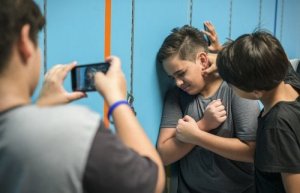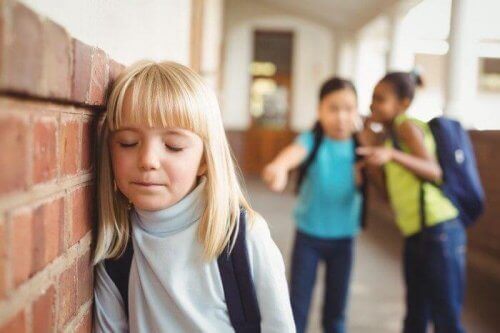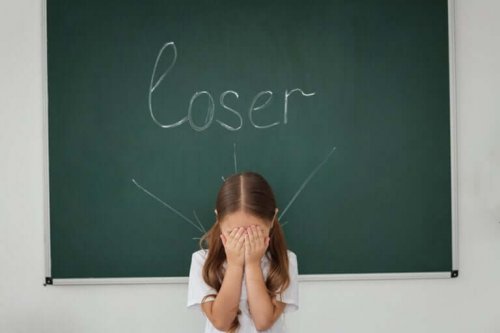Being a Witness to School Bullying

Nowadays, we’re accustomed to hearing about social and school inclusion. Nonetheless, every day in schools around the world, there are cases in which children may be the victim, aggressor, or witness to school bullying.
Don’t forget that inclusive education consists of seeking equality and not discriminating on the basis of race, sex, sexual orientation, physical appearance, disability, learning disability or difficulty, etc.
In order for children and young people to develop a positive coexistence among themselves, it’s important to instill good values. These certainly include respect, dialogue, cooperation, and empathy. Although, that’s not always enough. One of the great challenges that we still face is eradicating the occurrence of bullying at school.
What is school bullying and who is involved?
School bullying is a problem that manifests itself in schools around the world and a large number of students suffer daily. Above all, these students are subject to various acts of violence and harassment by their classmates.
If we have to think about the people involved, the first thing that comes to mind is the victim and the aggressor. That is to say, the affected person and the one who tries to make the victim’s life impossible through mockery, insults, and humiliation.
What happens to the classmates who act as spectators? We often forget the witness to school bullying has a fundamental role in perpetuating or stopping the violent situation and behavior, since they’re the direct observer of the aggression.
We have to keep in mind that the bully will feel stimulation or discouragement depending on the attitude of the bystanders. Therefore, we can state that there are three parties involved: the victim, aggressor and witness to bullying.

Types of witness to school bullying
Classmates who fulfill the function of witnessing school bullying can be classified as follows:
- Friends or accomplices: they belong to the group of friends or followers of the aggressor. On occasion, they participate in the attacks in the background, but without taking the initiative.
- Re-enforcers: they’re the children who don’t participate directly in the aggression; nevertheless, they approve of them and encourage them to continue taking place.
- Passive defenders: they’re the most numerous. They stay out of the event and observe without intervening, being accomplices of the aggressor with their silence. They assume a passive attitude since they’re afraid of becoming victims themselves of the bully.
- Defenders: these are the students who show their support for the victim. Moreover, they reject the bully’s actions and directly intervene by notifying an adult of what’s happening or consoling the victim.
Consequences of being a witness to school bullying
During our childhood and adolescence, we’re vulnerable beings to what we observe. Children who witness bullying also suffer consequences due to the continuation of violent acts they witness. This makes them receptors of negative learning and habits. Thus, they can end up:
- Respecting aggressive behavior.
- Internalizing criminal and antisocial behavior.
- Being desensitized to the suffering of others.
- Losing empathy for the victim.
- Having feelings of guilt.
- Assuming and feeling the victim’s sense of helplessness.
Social contagion
These children are usually affected by social contagion. This phenomenon consists of adopting the behavior of the dominant figure as a way of imposing oneself and seeking personal status. For this reason, some witnesses of school bullying learn to replicate the behaviors they observe in the aggressor.
Social contagion usually appears in children with the following characteristics:
- Critical and underdeveloped character.
- Self insecurity.
- Dependence on others.
- A tendency to go unnoticed.

In light of that, we must pay attention to the changes in behavior that children may have; both at school and at home. These negative behaviors may be due to the fact that they’re witnessing or participating in violent acts on an ongoing basis.
To prevent this, it’s very important to encourage them to reject violence and help those who need it. This way, they won’t incite the bully’s behavior and they’ll support the victim, either by listening, being a companion, or taking the victim away from the situation. Additionally, they’ll tell a trusted adult about the violent act that took place and they won’t be part of the bully’s followers.
A child who helps and acts in favor of the one who needs it is a child who helps to end bullying.
Nowadays, we’re accustomed to hearing about social and school inclusion. Nonetheless, every day in schools around the world, there are cases in which children may be the victim, aggressor, or witness to school bullying.
Don’t forget that inclusive education consists of seeking equality and not discriminating on the basis of race, sex, sexual orientation, physical appearance, disability, learning disability or difficulty, etc.
In order for children and young people to develop a positive coexistence among themselves, it’s important to instill good values. These certainly include respect, dialogue, cooperation, and empathy. Although, that’s not always enough. One of the great challenges that we still face is eradicating the occurrence of bullying at school.
What is school bullying and who is involved?
School bullying is a problem that manifests itself in schools around the world and a large number of students suffer daily. Above all, these students are subject to various acts of violence and harassment by their classmates.
If we have to think about the people involved, the first thing that comes to mind is the victim and the aggressor. That is to say, the affected person and the one who tries to make the victim’s life impossible through mockery, insults, and humiliation.
What happens to the classmates who act as spectators? We often forget the witness to school bullying has a fundamental role in perpetuating or stopping the violent situation and behavior, since they’re the direct observer of the aggression.
We have to keep in mind that the bully will feel stimulation or discouragement depending on the attitude of the bystanders. Therefore, we can state that there are three parties involved: the victim, aggressor and witness to bullying.

Types of witness to school bullying
Classmates who fulfill the function of witnessing school bullying can be classified as follows:
- Friends or accomplices: they belong to the group of friends or followers of the aggressor. On occasion, they participate in the attacks in the background, but without taking the initiative.
- Re-enforcers: they’re the children who don’t participate directly in the aggression; nevertheless, they approve of them and encourage them to continue taking place.
- Passive defenders: they’re the most numerous. They stay out of the event and observe without intervening, being accomplices of the aggressor with their silence. They assume a passive attitude since they’re afraid of becoming victims themselves of the bully.
- Defenders: these are the students who show their support for the victim. Moreover, they reject the bully’s actions and directly intervene by notifying an adult of what’s happening or consoling the victim.
Consequences of being a witness to school bullying
During our childhood and adolescence, we’re vulnerable beings to what we observe. Children who witness bullying also suffer consequences due to the continuation of violent acts they witness. This makes them receptors of negative learning and habits. Thus, they can end up:
- Respecting aggressive behavior.
- Internalizing criminal and antisocial behavior.
- Being desensitized to the suffering of others.
- Losing empathy for the victim.
- Having feelings of guilt.
- Assuming and feeling the victim’s sense of helplessness.
Social contagion
These children are usually affected by social contagion. This phenomenon consists of adopting the behavior of the dominant figure as a way of imposing oneself and seeking personal status. For this reason, some witnesses of school bullying learn to replicate the behaviors they observe in the aggressor.
Social contagion usually appears in children with the following characteristics:
- Critical and underdeveloped character.
- Self insecurity.
- Dependence on others.
- A tendency to go unnoticed.

In light of that, we must pay attention to the changes in behavior that children may have; both at school and at home. These negative behaviors may be due to the fact that they’re witnessing or participating in violent acts on an ongoing basis.
To prevent this, it’s very important to encourage them to reject violence and help those who need it. This way, they won’t incite the bully’s behavior and they’ll support the victim, either by listening, being a companion, or taking the victim away from the situation. Additionally, they’ll tell a trusted adult about the violent act that took place and they won’t be part of the bully’s followers.
A child who helps and acts in favor of the one who needs it is a child who helps to end bullying.
All cited sources were thoroughly reviewed by our team to ensure their quality, reliability, currency, and validity. The bibliography of this article was considered reliable and of academic or scientific accuracy.
- Garaigordobil, M. (2011). El maltrato entre iguales: definición, prevalencia, consecuencias, identificación e intervención. San Sebastián: Universidad del País Vasco.
- Serrate, R. (2007). Bullying: guía para entender y prevenir el fenómeno de la violencia en las aulas. Barcelona: Ediciones Laberinto.
- Trautmann, A. (2008). Maltrato entre pares o” bullying”: Una visión actual. Revista chilena de pediatría, 79(1), 13-20. doi: 10.4067/S0370-41062008000100002
This text is provided for informational purposes only and does not replace consultation with a professional. If in doubt, consult your specialist.








